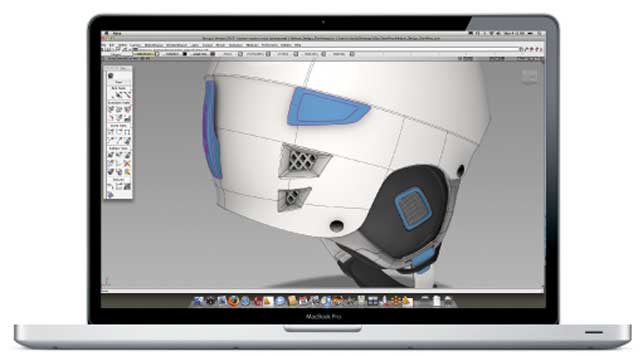When you talk about good design, Apple is probably the most commonly quoted example. From the iPhone and iPod to the Mac Pro and Mac Book Air, Apple’s iconic products certainly offer an enviable blend of form and function, but more importantly they are hugely in demand.
In recent years this demand has come from the product development industry, a sector that has been dominated by Windows-based applications since the late nineties. Design-attuned users have always been interested in Apple, but with the help of Bootcamp, a utility that allows users to set up a dual boot machine for Apple’s OS X operating system and Microsoft Windows, the hardware seems to be gaining serious traction amongst those working with 3D design tools.

Autodesk’s biggest endorsement for the Mac platform however came this year with a Mac OS X version of Alias, the company’s well-respected industrial design software
Running Windows on a beautifully designed computer is one thing, but to get the true Apple experience you need to be working natively with Apple’s OS X. While smaller vendors, such as Ashlar Vellum, have always offered Apple flavours of its software, the choice is still limited, but this has started to change.
Who’s doing what?
To date, most of the 3D software developments on the Mac platform have been for conceptual or industrial design. The exception to this is Siemens PLM, who released its NX application for OS X last year and is still the only major CAD/CAM vendor to do so. While most of the tools from the Windows version have been brought across to offer a capable modelling and CAM platform for product development, others such as CAE haven’t made the transition. This is because they rely on Windows-only component technology. N.B. NX is not a true Mac OS X application. It uses X-windows for its user interface.
For industrial design, McNeel and Associates is currently working on an OS X version of its surface modelling software, Rhino. In line with common Mac-based naming conventions this is called iRhino.
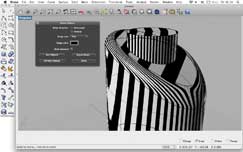
While not yet a commerical product, iRhino already has a huge following
McNeel is making the ‘in development’ version of iRhino available and free to anyone that wants to participate. This is the same approach McNeel took with the original Windows release of Rhino all those years ago, which proved hugely successful.
The company is spending years on its development of iRhino for OS X. The first task is to get the core functionality in place, then to build the UI to match the Mac users’ requirements and expectations, the importance of which was explained by Bob McNeel, CEO, “Our goal is a real OS X application that OS X users love… not a weird Windows port.” iRhino is expected to reach commercial release sometime after the release of Rhino 5 in a few years time.
Autodesk has also become increasingly active in the Mac space. While initially bringing tools from its Media and Entertainment division to the platform (such as Mudbox, Maya etc), the company has since released a Mac version of its sketching software, SketchBook Pro (a port of which has recently been made available on the iPhone).
Autodesk’s biggest endorsement for the Mac platform however came this year with a Mac OS X version of Alias, the company’s well-respected industrial design software. Alongside the Alias release, Autodesk is also considering a return to the Mac platform for its cash-cow, AutoCAD. Veteran Autodesk evangelist, Shaan Hurley, recently ran a survey on his blog to gather interest about AutoCAD for the Mac, something that hasn’t been seen since the nineties.
Another application that recently made the jump to Mac OS X is TurboCAD, the veteran AutoCAD alternative. While the Mac version doesn’t yet have the bells and whistles of the Windows variant, there are some good solid tools for working with two-dimensional drawings and it’s a nice Mac implementation.
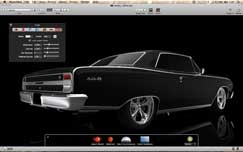
10% of Bunkspeed’s hypershot users are already on the Apple Mac plaftform
Out of the traditional realms of design Bunkspeed offers a Mac OS X version of its HyperShot progressive renderer. The interface of the initial Mac OS X release was more in tune with its Windows counterpart, but the second major generation of the system, which is currently in beta, features a fully Cocoa-compliant user interface. This conforms to Apple’s guidelines for developing truly Mac-native applications.
“We worked long and hard on developing the interface that turns HyperShot into a true Mac application that will be appreciated and embraced by all Mac users out there,” explains Bunkspeed’s Director of Marketing, Thomas Teger.
Running Windows on Mac
While running OS X-native is needed to get the true Mac experience, many Windows-based applications already run on Intel-based Apple hardware. This is because it’s possible to run both Windows (XP or Vista) and Mac OS X in dual boot mode using Bootcamp, a utility which comes free with Mac OS X. While performance is said to be virtually identical to when running Windows on PC hardware, the downside is that extra hard disk space is required for two operating systems and users need to reboot to alternate between them.
There are other alternatives to Bootcamp, namely Parallels Desktop and VMWare Fusion. Both these applications allow Windows to be installed and run from within Mac OS X, under emulation. However, there are drawbacks to running emulated Windows, namely that all system resources are shared, not all applications work properly (especially complex 3D ones like CAD) and emulation means there is a performance drop to be considered.
The other important consideration is support. While many applications will work fine under Bootcamp, they are not supported by the 3D software vendor. This means that if a user runs into technical problems they may be left unaided to resolve any issues.
This hasn’t deterred some users though and while SolidWorks, like many other vendors, doesn’t currently support its products under Bootcamp, we have heard from many users who still choose to run SolidWorks on Mac hardware.
Autodesk is one of the few CAD vendors that has embraced Bootcamp and currently supports Inventor, AutoCAD, and 3ds Max Design on 32-bit Windows XP and Vista. It has also just announced that it will support these and other applications under Parallels.
Technical challenges
Developing a native application for an entirely new platform is a major undertaking and there are many hurdles to overcome. Windows works very differently to the UNIX-based Mac OS X, and is one reason why those with existing UNIX applications, such as Autodesk (with Alias) and Siemens PLM (with NX,) have been able to deliver OS X-native applications comparatively quickly.
Designers and engineers are, by their very nature, attracted to well made things, and when you’ve got a laptop machined from a solid billet of aluminium how can you resist?
For Windows applications, in addition to the developers having to re-write their own code base, an Apple Mac port may be hindered by lack of support of component technologies, which are present in virtually all CAD applications. There may also be an impact downstream as the software often needs to work seamlessly with third-party applications, including PDM, simulation, and CAM.
Challenges also exist when it comes to hardware. While Apple’s move from Motorola PowerPC chips to Intel processors has made things easier, when it comes to 3D graphics the lack of professional level 3D graphics cards can be a barrier.
For all CAD applications, professional certified graphics cards are recommended to help ensure that what the user sees on screen is exactly what they are designing. Anomalies can occur when using consumer-level cards such as GeForce from Nvidia or Radeon from AMD.
In addition, professional features may not work with consumer-level cards. For example, Real View, the real time visualisation technology in SolidWorks or Autodesk’s ubiquitous View cube are not supported on consumer cards in Windows.
This is changing though. Nvidia has recently released a professional graphics card for the Mac platform, the Quadro FX 4800 for Mac. The problem is this is a particularly expensive graphics card, currently retailing for just under £1,500, and individual CAD products still need to be tested in order to be certified and supported. AMD currently has no plans to develop professional FirePro cards for the Mac platform and there are no professional graphics cards available on Apple’s laptops.
In addition, while OpenGL, the 3D graphics engine inside most CAD applications, works on Windows, UNIX and Mac OS X, its main alternative, a Microsoft technology called DirectX, only works on Windows.
The business case
Developing a software product for a new Operating System naturally requires a solid business case. Vendors need to be sure that they will get a return on investment as developing and supporting two code streams at the same time can put a huge demand on resources.
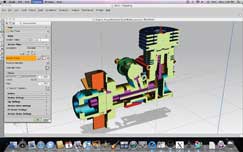
NX is the only major CAD/CAM application to be available on the Mac
Demand for Mac-based 3D design products is certainly there. However, despite a 4,000 signatory petition calling for a Mac-based version of SolidWorks, SolidWorks, that has 1,000,000 users globally, currently has no plans to develop a Mac-native version, as Shaun Murphy, CAD product manager at SolidWorks explains. “Support for an operating system is a major undertaking for a CAD company due to the legacy support implications. There has to be a demonstrated need for the new operating system by the company’s customer base. Our current research indicates that support for the Mac operating system is not at a level that makes business sense, less than half of one percent of our installed base.”
Demand, of course, is very hard to quantify but some developers take a more speculative view. “The user community for the OS X version [of Rhino] will most probably be in excess of 100,000,” states, McNeel’s Bob McNeel confidently, convinced the ‘free’ developmental approach he took with his original Windows version will be replicated when commercialising the Mac version of Rhino.
Thomas Herrman, the Senior Product Line Manager for Industrial Design at Autodesk feels demand from the creative sector is already very evident. “Based on our data, and talking to a lot of customers over the years, we believe roughly 30% of creative professionals prefer the Mac platform over Windows.”
And this view is echoed by Thomas Teger, Bunkspeed’s Director of Marketing, whose Mac-based customers currently make up 10% of its HyperShot user base. “The Mac community is traditionally all about the creativity. Photographers, retouchers, marketing people – all Mac,” he said. “Students in particular are gravitating very strongly to the Mac, but also more and more design houses.”
On the other side of the fence, the cost justification for designers and engineers to buy Apple hardware may be much harder. While prices have come down, Apple Macs are still more expensive than most Windows-based computers. Added to this, many of the larger corporations are tied into to one vendor for all their IT requirements, from basic office machines, right through to high-end design workstations. With this in mind, Apple is likely to appeal more to agile, smaller companies.
The future
Apple has always been popular in “creative” industries, and while historically this has meant graphic design or film editing, it’s clear that there’s a growing interest from the world of product development. But this has nothing to do with cost or performance, traditional metrics on which computers are measured. When it comes to Mac it all comes down to a love of the product – people choose Apple hardware because they love it, they love the design, they love the simplicity of the OS; they love the quality.
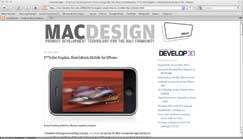
DEVELOP3D for Mac lovers: With such a visible increase in momentum for Mac-based product development technology, six months ago we set up mac.develop3d.com, a dedicated micro-site to bring you all the latest news in this sector. During this time we’ve been busy, talking to both users and vendors about why, after years of dormancy in the product development world, Apple’s hardware and operating system are currently seeing a renaissance.
mac.develop3d.com
From talking to a number of Mac fans over the past few months it’s clear that much of this adoration is coming from the student community. One budding industrial designer, @Ryan_McG on Twitter, who recently acquired a MacBook Pro to run SolidWorks under Bootcamp, shared the love. “It’s one of the most beautiful products I’ve ever seen, never mind invested in.”
And while there is plenty of interest from practising engineers and designers, it’s this next generation of professionals that will surely drive demand for CAD on the Mac in the coming years. Indeed, while most software vendors aren’t yet reporting huge sales, it’s likely to be a long-term strategy that will see success on the platform.
The most puzzling thing is Apple itself, who doesn’t currently seem to recognise the size and potential of this market. Designers and engineers are, by their nature, attracted to well-made objects, and when you’ve got an incredibly slick, slender laptop machined from a solid billet of aluminium, such as the new Mac Book Pro, how can you resist? The editorial team at DEVELOP3D certainly can’t.
Design tools on the Mac: What’s out there?
Conceptual design
SketchBook Pro
Modo
Silo
CAD
VectorWorks
TurboCAD
Shark Punch/FX
Siemens PLM NX 6
Alias Design
Rendering
Blender
Form Z
HyperShot
Modo
PCB design
Eagle 5.2
Viewing & collaboration
eDrawings for Mac
Apple terminology 101
Apple OS X First released in 2002, this saw a UNIX-code base used to develop the Apple operating system. The current version, Snow Leopard, brings Microsoft Exchange interoperability (meaning you don’t have to use the dreadful Outlook for Mac called Entourage) and have full compliancy with Exchange Server set-ups.
Bootcamp Introduced with OS X Leopard, this gives users the ability to dual boot both OS X and WIndows (and Linux if you so choose). Apple develops a set of drivers for Windows, so you simply start off the process, install Windows, and it’s up and running.
Cocoa Cocoa is Apple’s name for the collection of frameworks, APIs, and accompanying runtimes that make up the development layer of Mac OS X. It also gives developers the tools they need to develop a true Mac look and feel for their applications.
MacBook While Apple makes ultra powerful desktop systems, the real push in recent years has been its range of notebook or laptop computers, named MacBook. While the MacBook Air is an ultraportable, for those looking for performance and portability, the MacBook Pro range is where it’s at, available in 15” and 17” models.
X-Windows This gives developers the ability to ‘quickly’ port UNIX-based code across to OS X. Siemens PLM NX uses X-windows to provide its user interface – other vendors have eschewed X-Windows and gone ‘native’.
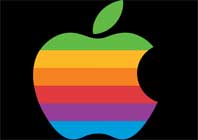
The growing interest in Apple from the world of product development

